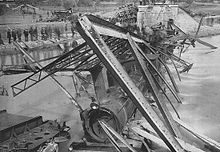- Munchenstein rail disaster
-
The Munchenstein rail disaster on 14 June 1891 was historically the worst railway accident ever to affect Switzerland. [1]
A crowded passenger train fell through a girder bridge, killing over seventy people and injuring many more. The accident occurred on the railway line between Basel and Delémont, near the Brückgut just below the village centre of Munchenstein, as the train was traversing the bridge across the river Birs.
Contents
Bridge
The single-track bridge had been built in 1874-75 by Gustave Eiffel (1832-1923), who went on to build the Eiffel Tower in 1889. The contract was given to the young architect's office by the Jurabahn (later Jura–Simplon Railway), a private Railway company. Eiffel's engineering company had already acquired the necessary experience, having previously planned and built numerous railway bridges and viaducts in France such as that at Rouzat and Bouble in the Massif Centrale, and the Garabit viaduct in France.
The bridge was composed of wrought iron lattice girders, with an overall length of 42 metres. It crossed the river some five metres above water level at an angle of 51°, and it was completed and put into use in 1875. There were no reasons for complaint, even after serious local floods on the river Birs in 1881, but it was repaired and modified thereafter. One of the abutments was destroyed, leaving the bridge resting on just three points rather than pier. As one corner sank under its own weight, serious cracks were produced. The affected parts were replaced, and further strengthening was done in 1890 after the introduction of heavier locomotives.
Disaster
On 14 June 1891 at 14:15 a train left the main Basel railway station for Delémont. Owing to the large number of passengers two supplementary passenger carriages and an additional engine had been added to the train at the last moment. In the findings of the examination report it was estimated that the number of travellers aboard was between 530 and 550.
The disaster occurred as the passenger train, which had been travelling at full speed, applied its brakes before and whilst crossing over the bridge, immediately before entering the Münchenstein railway station. Eye witnesses said that the bridge appeared to break in the centre as the front wheels of the locomotive reached the further abutment. The train did not derail at any time during the collapse.
The front part of the train, the two engines, the two additional passenger carriages, a postal carriage, an express carriage and two further passenger carriages, fell into the river. The first two passenger carriages sank in the floods of the river, as the following wagons pushed them forwards. A further passenger carriage hung diagonally from the abutment facing downwards towards the river. The final five passenger wagons remained upon the tracks, virtually undamaged.
As the first carriages fell into the river, the air brake system pipes were severed and the brakes in the rear wagons were therefore instantly applied, keeping these wagons standing on the tracks. Most of the passengers in the rear part of the train were uninjured.
The disaster claimed the lives of 73 and seriously injured 171 people.
Inquiry
The subsequent inquiry focused on the state of the bridge, the quality of the ironwork and the design. A new institute "Empa" (Building materials test institute) started work in 1880. In its first years of activity, "Empa" was involved in wide-ranging quality testing of building and structural materials for the Swiss National Exhibition of 1883. Intensive research work by the co-founder and first director, Prof. Ludwig von Tetmajer, gave rise to the first publications on the testing and standardisation of building materials and metals. Tetmajer was also commissioned to investigate the cause of the collapse of the Münchenstein railway bridge: his investigation of the collapse (which was responsible for what was at that time the worst railway disaster to have occurred in Europe) revealed that Euler's formula for buckling, which had hitherto been used to calculate design loads in such structures, needed to be corrected for slender bars.
See also
- List of bridge failures
- Lists of rail accidents
Bibliography
- Schneider, A and Mase, A, Railway Accidents of Great Britain and Europe, David & Charles (1970).
References
Coordinates: 47°31′04″N 7°37′06″E / 47.5176861722°N 7.61833190917°E
Categories:- Münchenstein
- Railway accidents in Switzerland
- Railway accidents in 1891
- Bridge disasters in Switzerland
- Bridge disasters caused by engineering error
Wikimedia Foundation. 2010.

